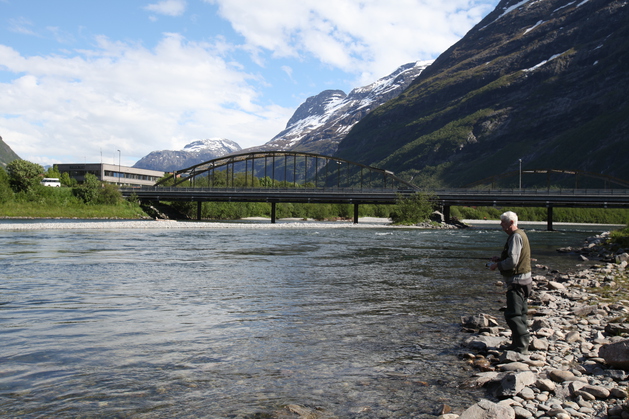Wild salmon adapt to gyro – but it takes a long time

Wild Atlantic salmon demonstrate an increasing ability to tolerate the gyro parasite over generations. But targeted selective breeding is needed if salmon are to acquire high survival in infected rivers in not too many years.
The parasite Gyrodactylus salaris is often referred to as the “salmon killer”. Bjarne Gjerde prefers to use the more neutral short form “gyro”. Before he retired, Gjerde was a researcher with Nofima, where he conducted research on salmon’s resistance to gyro.
Lethal medicine
“Gyro has been a problem in many salmon rivers since the mid-1970s,” he says. The chemical treatment that has killed the parasite in many rivers is both extensive and expensive. Yes, it kills the gyro – but also all the salmon and several other species in the river.

“That’s why we wanted to investigate whether salmon in infected rivers are subjected to natural selection against the parasite,” says Gjerde.
He has looked into whether the salmon that survive in a gyro-infested river acquires increased resilience that is passed on to the next generations.
The researchers collected eyed eggs from six wild Atlantic salmon populations in Norway – from three infected rivers and three healthy rivers close to the infected ones. They also used eyed eggs with origin from the Neva river in Russia, where the salmon has already adapted to withstand the gyro.
Too small differences
The eyed salmon eggs were hatched at Nofima, Sunndalsøra, and the fry were infected with gyro infected fry from the Driva river in order to examine how well fry from the various salmon populations fared. After 84 days, 36 percent of the fry were still alive.
“We found that the fry from the three infected Norwegian river strains had a higher survival rate than fry from the three uninfected strains,” says Bjarne Gjerde. The difference was not very large – 31.6 per cent versus 25.3 per cent – but it was significant; that is, there is no doubt there really is a difference.
As expected, the fry from the Neva river had the highest survival rate: 67.9 per cent.
This means that the salmon populations that have already been exposed to the parasite fare a little better against it. However, the differences between the Norwegian populations are so small that it will probably take a very long time for nature to sort it out without help.
“Theoretical calculations indicate that it will take perhaps as many as 30–40 salmon generations,” says Gjerde. When one generation equals six years, this means the natural process will take from 180 to 240 years.
Breeding for resistance
However, the researchers also found large genetic variations in mortality between the individual fish within each of the infected river strains. This means that it may be possible to combat the parasite through targeted selective breeding, which would make it possible to achieve higher resistance to Gyrodactylus salaris within fewer generations than what nature needs to sort it out on its own.

“This might therefore represent a possible strategy in rivers where eradication of the parasite with chemicals is impossible, Gjerde and his colleagues suggest in a recent article in the journal Naturen.
“A big downside to this is that every year a controlled infection test must be carried out in each infected river, with a subsequent large-scale release of eyed eggs or fry from the best fish found during the infection testing.”
Sorting in the river
The researchers found two QTLs – that is, specific areas on two different chromosomes of the salmon – that explained a significant proportion of their genetic variation in resistant to gyro.
“This means that we can speed up the process of natural selection without conducting infection tests on a yearly basis. In the Drammenselva river, for example, all the fish are captured in a trap in Hellefoss near Hokksund. We could take a tissue sample of each fish, and then release only those who have potential to develop resistance. This will speed up their evolution, as only those with the best genes will swim back to the upper reaches of the river to spawn,” explains Gjerde.
He stresses that the researchers’ findings are based on the mortality of fish in a controlled infection test conducted in tanks. The question is whether the QTLs are as effective in a natural setting.
“We could have tested this QTL strategy while we wait for treatment of the river,” he says.
Publication
Contact person
Research areas
Breeding and genetics
Topics
Breeding programs
Research facilities
